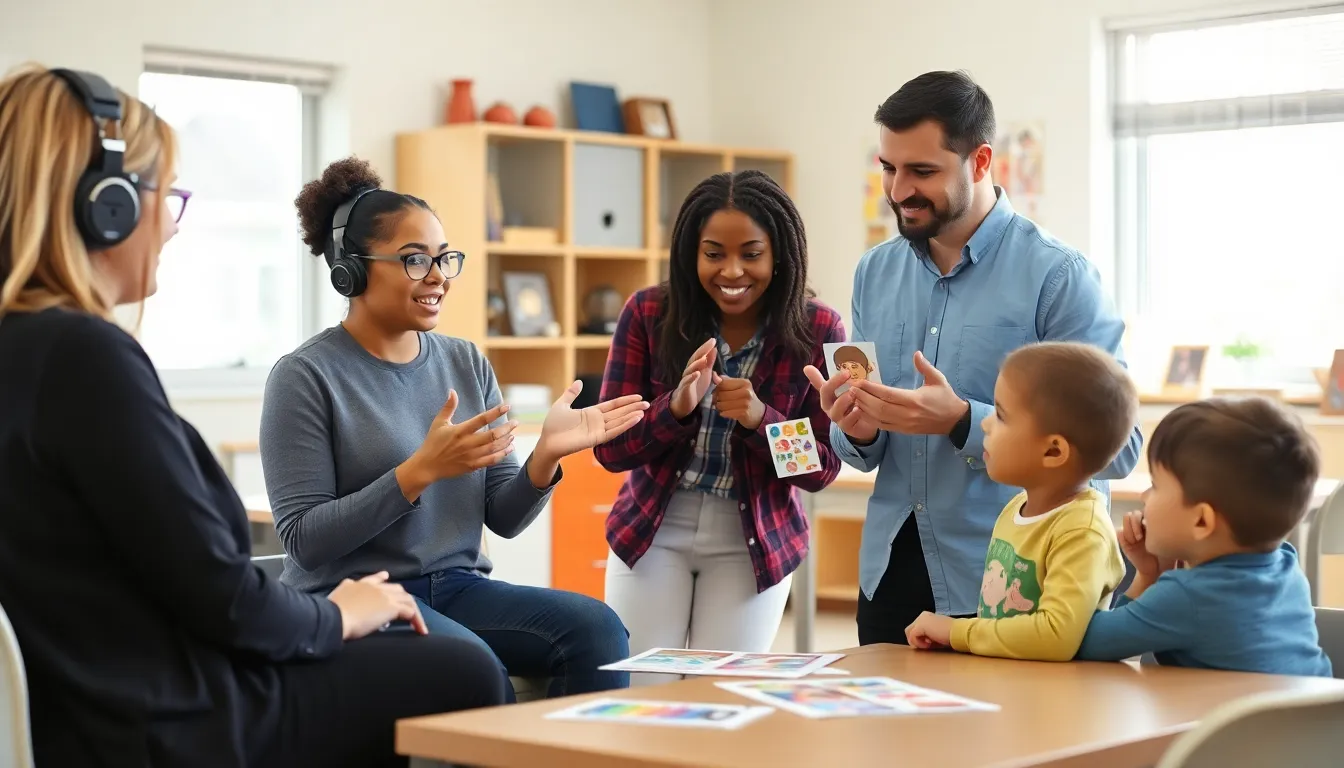In a world where emojis can speak louder than words, alternative communication is shaking things up. Whether it’s sign language, pictograms, or even interpretive dance (yes, really), these methods offer fresh ways to connect when traditional chatting just doesn’t cut it. Imagine trying to have a deep conversation while juggling a taco—alternative communication swoops in like a superhero to save the day!
Table of Contents
ToggleOverview Of Alternative Communication
Alternative communication methods serve as valuable tools when traditional verbal interaction isn’t possible. Sign language represents one of the most recognized alternatives, offering users a complete linguistic structure for expressing thoughts. Pictograms also play a crucial role, allowing individuals to convey messages through visual symbols, making communication accessible for non-verbal individuals.
Many people utilize augmentative and alternative communication (AAC) devices, which include speech-generating technologies that help articulate messages. These assistive devices enable effective conversation for those with speech impairments, bridging gaps in communication. Similarly, gestures and body language enrich interactions, providing context and emotional nuance to conversations.
Visual schedules help in daily planning for individuals with disabilities. By using structured imagery, these schedules facilitate comprehension and encourage independence. Additionally, written communication, whether through text messages or written notes, often proves effective for those facing challenges in verbal exchanges.
Interpretive dance emerges as an innovative form of communication, allowing individuals to express emotions and ideas through movement. This creative form transcends linguistic barriers, inviting audiences to interpret meaning based on the performed gestures. Ultimately, alternative communication methods provide an inclusive environment, fostering connections among diverse populations.
Types Of Alternative Communication

Alternative communication encompasses various methods that enhance interactions. Each type serves specific needs and contexts.
Augmentative And Alternative Communication (AAC)
AAC refers to tools and strategies that support individuals with speech impairments. Devices like speech-generating software produce verbal messages, improving communication capabilities. Systems may include eye-tracking technology for users with limited mobility. Additionally, text-based communication allows users to formulate thoughts promptly. Many AAC devices provide customizable options, helping users express their unique voices. Studies show that effective AAC implementation leads to improved social interactions and enhanced quality of life.
Sign Language
Sign language acts as a fully developed linguistic system that conveys meaning through hand signs, facial expressions, and body movements. It serves the Deaf and hard-of-hearing communities, ensuring effective communication. Notably, several sign languages exist globally, each with distinct grammar and vocabulary. Sign language fosters inclusivity, allowing individuals to engage more comfortably without reliance on spoken words. Research highlights its importance in promoting accessibility and social connections while breaking down barriers in communication.
Picture Exchange Communication System (PECS)
PECS utilizes visual symbols to assist individuals in communicating their needs and desires. Originally designed for individuals with autism, it enables users to exchange pictures for expressing thoughts. Through this method, users learn to communicate more independently by arranging symbols to create sentences. Many educators incorporate PECS into their classrooms to enhance learning and social interaction. Implementation of PECS often leads to significant improvements in functional communication and participant engagement.
Benefits Of Alternative Communication
Alternative communication fosters important interpersonal connections and aids individuals in expressing themselves effectively. Diverse methods enhance communication skills while promoting understanding among users.
Enhancing Communication Skills
Alternative communication strategies significantly improve overall communication skills. Many individuals find that using visual aids, like pictograms, clarifies complex ideas. Organized methods of expression often lead to more effective conversations. Sign language provides a complete linguistic system, allowing for nuanced discussions without reliance on spoken words. Each gesture conveys meaning, often adding emotional depth. Those who incorporate augmentative and alternative communication devices also report enhanced ability to communicate. Users gain confidence when mastering these tools, leading to more meaningful interactions.
Increasing Independence
Independence for individuals with communication challenges increases through alternative communication methods. Visual schedules enable users to manage daily tasks efficiently. Devices like speech-generating tools empower individuals to express needs without assistance, enhancing self-sufficiency. Additionally, systems such as the Picture Exchange Communication System offer individuals with autism a way to independently communicate. Empowerment grows as users explore these alternatives, promoting a sense of agency. When individuals have accessible methods for communication, their quality of life improves significantly, leading to a more fulfilling daily experience.
Challenges In Implementing Alternative Communication
Implementing alternative communication methods presents various challenges. These obstacles can hinder effective communication for individuals who rely on these strategies.
Accessibility Issues
Accessibility remains a significant challenge in alternative communication. Many environments lack the necessary tools, like sign language interpreters or AAC devices. Inaccessible venues can prevent individuals from fully participating in conversations. Training programs need to address these gaps effectively. Communities must also foster awareness about the importance of providing resources for everyone. Furthermore, some alternative methods, such as pictograms, may not be readily available in all settings, limiting their potential impact.
Training And Support Needs
Training and support play crucial roles in successful implementation. Many caregivers and educators require comprehensive training to utilize alternative communication effectively. Workshops can provide valuable insights into various tools and techniques. Regular support also ensures that users remain confident and proficient in their communication methods. Without ongoing assistance, individuals may struggle to maximize the advantages of alternative communication. Developing community support networks can enhance skills and create more inclusive environments.
Future Trends In Alternative Communication
Emerging technologies are shaping the future of alternative communication. Innovations like artificial intelligence enhance the capabilities of augmentative and alternative communication devices. Wearable devices now facilitate real-time communication for individuals with hearing impairments.
Incorporating virtual reality into alternative communication offers immersive experiences. This technology creates environments for practicing social interactions, benefiting individuals who face social challenges. Think of virtual platforms that simulate conversations and enhance learning for various communication styles.
Expanding the accessibility of communication aids is vital as societal needs evolve. Universal design principles aim to include individuals with diverse communication needs in every aspect of life. This approach leads to the development of adaptable tools that cater to various users, from children with speech delays to adults with acquired communication disorders.
Increasing awareness of the importance of alternative communication fosters community initiatives. Organizations actively promote training for educators and caregivers in using alternative communication methods. This effort enhances user confidence and encourages effective communication strategies in everyday contexts.
Research continues to highlight the benefits of integrating alternative communication into educational settings. Educators now recognize that alternative communication tools can significantly improve learning outcomes for students with speech and language difficulties. Increased focus on inclusivity encourages the implementation of alternative communication strategies in classrooms.
Overall, collaboration among developers, therapists, and educators drives innovation. Engaging these stakeholders ensures that emerging tools address real-world needs, promoting effective communication for diverse individuals. This collective effort advances understanding and acceptance of alternative communication in society.
Alternative communication methods are transforming the way individuals connect and express themselves. By embracing tools like sign language and AAC devices, society can foster inclusivity and enhance interpersonal relationships. The ongoing development of technology and community support initiatives plays a crucial role in expanding access to these vital resources.
As awareness grows and training becomes more widespread, the potential for meaningful communication will continue to flourish. Ultimately, integrating alternative communication into everyday interactions not only enriches lives but also paves the way for a more understanding and connected world.




